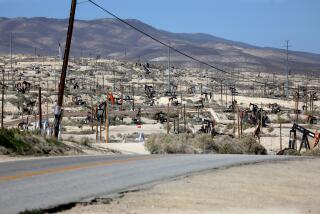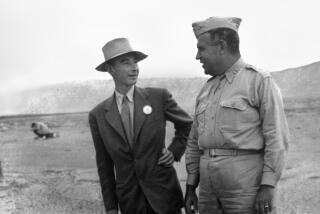He got away from it all -- and left behind a mystery
- Share via
In an old photograph, Albert Clark Reed looks like just another balding man in a coat and tie, a 45-year-old husband and father from the 1950s. He has a thin mustache and a pleasant half-smile that looks as if he were being coached by some portrait photographer.
His wife, Florence, called him a “cool, levelheaded scientist and test pilot.” He graduated from Caltech in 1929 and returned for more studies in 1932. During World War II, he was a flier and worked on classified military projects, The Times said in 1954. After the war, he and Florence lived in Seattle, where he tested and designed aircraft for Boeing.
Albert and Florence moved to Pasadena in 1944 and bought a home near the Rose Bowl. A few years later, they had a son, Timothy James. Albert and Florence had had some arguments, but apparently nothing was seriously amiss. And maybe they had some money problems.
“He loved to bet the horses,” Florence said. “Bet them heavily. Even owned two horses once. I don’t know. He may have been having financial troubles. He never mentioned finances to me. I know he made a good deal of money. As much as $3,000 or more a month. But he never discussed such things with me.”
In early 1952, Albert finished work on Project Vista, a controversial program stemming from the Korean War that also evaluated how existing technology -- including nuclear weapons on the battlefield -- could be used by NATO countries to repel an attack by superior forces of the Soviet Union.
That summer, he was scheduled to meet with military officials in Washington about some classified matter; it’s not clear what it was.
On Monday, July 7, 1952, Albert got into his 1941 sedan with his briefcase and bag of clothing and headed for Caltech, according to The Times.
But he never arrived on campus.
The years passed -- years of waiting and wondering and investigation by police and the FBI. Years of crackpot calls and crushed expectations.
Until she died in December 1955 at the age of 39, Florence never gave up hope that Albert would return.
“I want Al to know that if it’s a matter of pride, if he’s ashamed to come back, if . . . well, no matter what he’s done, I want him to know we want him back. No matter what he’s done,” she told The Times in July 1954.
Florence couldn’t keep up the house payments, and without proof that Albert was dead, she couldn’t claim any money on his large insurance policies. So she let them lapse.
She and Timmy moved to South Pasadena, and she got a job selling welding rods and did public relations until she had a nervous breakdown. Albert’s disappearance was especially hard on their son, who had a heart ailment, The Times said.
When Florence died, Timmy went to live with relatives back East and changed his last name to theirs.
Police had a few leads: Albert sold his sedan to a Pasadena car dealer for $106. He sent Florence his driver’s license and a handwritten will in an envelope postmarked San Bernardino. The day after he vanished, a woman called Florence and said, “Your husband is being held for information” and “The plans are in the den.”
In 1955, an acquaintance said he ran into Albert in San Gabriel and they had a few drinks. Albert said he was going to go home and clear up his family affairs. But he never did.
In June 1958, Alfred Cole Reese appears in news photos. He’s 51, lanky and muscular, tough and wiry and completely bald. He’s wearing jeans and a denim work shirt with sleeves rolled up, exposing muscular arms. Alfred looks like a hardened endurance runner. His face is lean and his eyes are tired and sad, The Times said.
Alfred could fill in some of the missing pages of his life -- what he did after he disappeared and changed his name -- but he couldn’t explain why.
After selling the car that morning in 1952, he had taken a bus to Phoenix, where he got a job through the Teamsters moving freight. Eventually he wound up working with horses and became a racetrack groom, migrating from Del Mar to Santa Anita to Hollywood Park, wherever there was a job.
Horses, he said, are “wonderful, intelligent, sensible creatures. I enjoy working with them.”
No one around the racetracks suspected he had ever been a leading scientist, The Times said. All they knew was that Alfred had a good way with horses: “One of the best grooms I ever had,” his employer told The Times.
If it hadn’t been for a new law that required racetrack employees to be fingerprinted, Albert’s life as Alfred might have remained a secret forever.
In looking at Albert’s story, some people saw a rebel courageously abandoning the 1950s rat race run by the men in the gray flannel suits.
The only man who could explain his behavior was at a total loss for why he vanished.
“Time and time again, he closed his eyes for long seconds after a question, his facial muscles working, his tired mind focusing futilely on blurred pictures,” The Times said.
“And time and time again, he answered softly:
“ ‘I can’t recall . . .
“ ‘I don’t know . . .
“ ‘I’m so confused.’ ”
At first, Albert intended to keep working with horses. He had a warm reunion with Timmy, but decided his son was better off with relatives.
By 1959, after some refresher classes at UCLA, Albert reentered the aerospace industry, at Del Mar Engineering Laboratories, which made weapons training systems for interceptor pilots. He was living in Brentwood and had bought a horse.
“It seemed to me that maybe I could contribute something to our national security,” he told The Times in July 1959. He still couldn’t answer the lingering question of why he vanished.
An unidentified Times reporter asked whether he thought he might someday return to the stables.
“You can never tell,” he said.
And with that, Albert disappeared from the pages of The Times.
Postscript: After Florence died, an attorney handling her estate discovered that she’d had a secret life as well. Using the name Florence Green, she had hidden $17,500 (about $140,000 today) in cash and jewelry in five Pasadena banks.
--
--
Read more about L.A. history at the Daily Mirror blog. latimesblogs .latimes.com/thedailymirror
More to Read
Sign up for Essential California
The most important California stories and recommendations in your inbox every morning.
You may occasionally receive promotional content from the Los Angeles Times.













